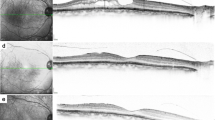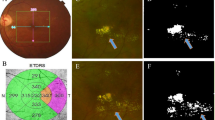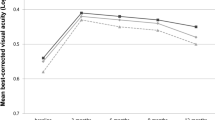Abstract
Purpose
To investigate morphological changes of intraretinal cyst in association with visual acuity following treatment for diabetic macular edema.
Methods
This retrospective study enrolled 105 eyes from 105 treatment naïve patients with diabetic macular edema following anti-vascular endothelial growth factor injections. Best-corrected visual acuity (BCVA) and optical coherence tomography (OCT) data were obtained at baseline, 1, 3, 6, and 12 months. The width and height of the largest intraretinal cyst (IRC) at all different visits were measured and were correlated to final visual acuity by receiver operating characteristic curve. The exudative feature was defined by the presence of hard exudates. Multivariate logistic regression was used to select the independent predictor for visual outcomes.
Results
Intraretinal cyst width but not the cyst height after treatment at 1 month independently predicted final visual loss of ten letters or more (multivariate P = 0.009). The optimal cutoff value was 196 um with a sensitivity of 0.889 and a specificity of 0.656. Eyes with large IRC width using this cutoff were consistently larger than those with small IRC width through 12 months (P = 0.008, Mann–Whitney U test). Small IRC width < 196 um at 1 month was more likely to coexist with exudative feature (P = 0.011, Fisher’s exact test). Among baseline factors, large IRC width predicted IRC width ≥ 196 um at 1 month (multivariate P < 0.001).
Conclusion
Cyst morphology following intravitreal injection predicts visual outcomes. Eyes with IRC width ≥ 196 um after treatment at 1 month tends to be more degenerative, and less likely to coexist with exudative feature.





Similar content being viewed by others
References
Flaxman SR, Bourne RRA, Resnikoff S, Ackland P, Braithwaite T, Cicinelli MV, Das A, Jonas JB, Keeffe J, Kempen JH, Leasher J, Limburg H, Naidoo K, Pesudovs K, Silvester A, Stevens GA, Tahhan N, Wong TY, Taylor HR (2017) Global causes of blindness and distance vision impairment 1990–2020: a systematic review and meta-analysis. Lancet Glob Health 5:e1221–e1234. https://doi.org/10.1016/s2214-109x(17)30393-5
Das A, McGuire PG, Rangasamy S (2015) Diabetic macular edema: pathophysiology and novel therapeutic targets. Ophthalmology 122:1375–1394. https://doi.org/10.1016/j.ophtha.2015.03.024
Daruich A, Matet A, Moulin A, Kowalczuk L, Nicolas M, Sellam A, Rothschild PR, Omri S, Gélizé E, Jonet L, Delaunay K, De Kozak Y, Berdugo M, Zhao M, Crisanti P, Behar-Cohen F (2018) Mechanisms of macular edema: beyond the surface. Prog Retin Eye Res 63:20–68. https://doi.org/10.1016/j.preteyeres.2017.10.006
Spaide RF (2016) Retinal vascular cystoid macular edema: review and new theory. Retina 36:1823–1842. https://doi.org/10.1097/iae.0000000000001158
Sophie R, Lu N, Campochiaro PA (2015) Predictors of functional and anatomic outcomes in patients with diabetic macular edema treated with ranibizumab. Ophthalmology 122:1395–1401. https://doi.org/10.1016/j.ophtha.2015.02.036
Roberts PK, Vogl WD, Gerendas BS, Glassman AR, Bogunovic H, Jampol LM, Schmidt-Erfurth UM (2020) Quantification of fluid resolution and visual acuity gain in patients with diabetic macular edema using deep learning: a post hoc analysis of a randomized clinical trial. JAMA Ophthalmol 138:945–953. https://doi.org/10.1001/jamaophthalmol.2020.2457
Kwon JW, Kim B, Jee D, Cho YK (2021) Aqueous humor analyses of diabetic macular edema patients with subretinal fluid. Sci Rep 11:20985. https://doi.org/10.1038/s41598-021-00442-z
Panozzo G, Cicinelli MV, Augustin AJ, Battaglia Parodi M, Cunha-Vaz J, Guarnaccia G, Kodjikian L, Jampol LM, Jünemann A, Lanzetta P, Löwenstein A, Midena E, Navarro R, Querques G, Ricci F, Schmidt-Erfurth U, Silva RMD, Sivaprasad S, Varano M, Virgili G, Bandello F (2020) An optical coherence tomography-based grading of diabetic maculopathy proposed by an international expert panel: The European school for advanced studies in ophthalmology classification. Eur J Ophthalmol 30:8–18. https://doi.org/10.1177/1120672119880394
Bringmann A, Reichenbach A, Wiedemann P (2004) Pathomechanisms of cystoid macular edema. Ophthalmic Res 36:241–249. https://doi.org/10.1159/000081203
Scholl S, Kirchhof J, Augustin AJ (2010) Pathophysiology of macular edema. Ophthalmologica 224(Suppl 1):8–15. https://doi.org/10.1159/000315155
Murakami T, Nishijima K, Akagi T, Uji A, Horii T, Ueda-Arakawa N, Muraoka Y, Yoshimura N (2012) Optical coherence tomographic reflectivity of photoreceptors beneath cystoid spaces in diabetic macular edema. Invest Ophthalmol Vis Sci 53:1506–1511. https://doi.org/10.1167/iovs.11-9231
Yalçın G, Özdek Ş, Baran Aksakal FN (2019) Defining cystoid macular degeneration in diabetic macular edema: an oct-based single-center study. Turk J Ophthalmol 49:315–322. https://doi.org/10.4274/tjo.galenos.2019.22687
Arf S, Sayman Muslubas I, Hocaoglu M, Ersoz MG, Ozdemir H, Karacorlu M (2020) Spectral domain optical coherence tomography classification of diabetic macular edema: a new proposal to clinical practice. Graefes Arch Clin Exp Ophthalmol 258:1165–1172. https://doi.org/10.1007/s00417-020-04640-9
Deák GG, Bolz M, Ritter M, Prager S, Benesch T, Schmidt-Erfurth U (2010) A systematic correlation between morphology and functional alterations in diabetic macular edema. Invest Ophthalmol Vis Sci 51:6710–6714. https://doi.org/10.1167/iovs.09-5064
Mané V, Dupas B, Gaudric A, Bonnin S, Pedinielli A, Bousquet E, Erginay A, Tadayoni R, Couturier A (2016) Correlation between cystoid spaces in chronic diabetic macular edema and capillary nonperfusion detected by optical coherence tomography angiography. Retina 36(Suppl 1):S102-s110. https://doi.org/10.1097/iae.0000000000001289
Yalçın NG, Özdek Ş (2019) The relationship between macular cyst formation and ischemia in diabetic macular edema. Turk J Ophthalmol 49:194–200. https://doi.org/10.4274/tjo.galenos.2018.19616
Lee H, Kang KE, Chung H, Kim HC (2019) Three-dimensional analysis of morphologic changes and visual outcomes in diabetic macular edema. Jpn J Ophthalmol 63:234–242. https://doi.org/10.1007/s10384-019-00657-8
Loganadane P, Delbosc B, Saleh M (2019) Short-term progression of diabetic hard exudates monitored with high-resolution camera. Ophthalmic Res 61:3–9. https://doi.org/10.1159/000493858
Murakami T, Tsujikawa A, Miyamoto K, Sakamoto A, Ota M, Ogino K, Yoshimura N (2012) Relationship between perifoveal capillaries and pathomorphology in macular oedema associated with branch retinal vein occlusion. Eye (Lond) 26:771–780. https://doi.org/10.1038/eye.2012.85
Muftuoglu IK, Mendoza N, Gaber R, Alam M, You Q, Freeman WR (2017) Integrity of outer retinal layers after resolution of central involved diabetic macular edema. Retina 37:2015–2024. https://doi.org/10.1097/iae.0000000000001459
Tsai MJ, Cheng CK (2021) Intravitreal aflibercept versus ranibizumab for diabetic macular edema in a taiwanese health service setting. Semin Ophthalmol 36:132–138. https://doi.org/10.1080/08820538.2021.1889620
Zweifel SA, Engelbert M, Laud K, Margolis R, Spaide RF, Freund KB (2009) Outer retinal tubulation: a novel optical coherence tomography finding. Arch Ophthalmol 127:1596–1602. https://doi.org/10.1001/archophthalmol.2009.326
Rewbury R, Want A, Varughese R, Chong V (2016) Subfoveal choroidal thickness in patients with diabetic retinopathy and diabetic macular oedema. Eye (Lond) 30:1568–1572. https://doi.org/10.1038/eye.2016.187
Lent-Schochet D, Lo T, Luu KY, Tran S, Wilson MD, Moshiri A, Park SS, Yiu G (2021) Natural history and predictors of vision loss in eyes with diabetic macular edema and good initial visual acuity. Retina 41:2132–2139. https://doi.org/10.1097/iae.0000000000003167
Karahan E, Abdelhakim A, Durmaz C, Tezel TH (2020) Relief of cystoid macular edema-induced focal axonal compression with anti-vascular endothelial growth factor treatment. Transl Vis Sci Technol 9:18. https://doi.org/10.1167/tvst.9.4.18
Gerendas BS, Prager S, Deak G, Simader C, Lammer J, Waldstein SM, Guerin T, Kundi M, Schmidt-Erfurth UM (2018) Predictive imaging biomarkers relevant for functional and anatomical outcomes during ranibizumab therapy of diabetic macular oedema. Br J Ophthalmol 102:195–203. https://doi.org/10.1136/bjophthalmol-2017-310483
Reichenbach A, Wurm A, Pannicke T, Iandiev I, Wiedemann P, Bringmann A (2007) Müller cells as players in retinal degeneration and edema. Graefes Arch Clin Exp Ophthalmol 245:627–636. https://doi.org/10.1007/s00417-006-0516-y
Michl M, Fabianska M, Seeböck P, Sadeghipour A, Haj Najeeb B, Bogunovic H, Schmidt-Erfurth UM, Gerendas BS (2022) Automated quantification of macular fluid in retinal diseases and their response to anti-VEGF therapy. Br J Ophthalmol 106:113–120. https://doi.org/10.1136/bjophthalmol-2020-317416
Santos AR, Alves D, Santos T, Figueira J, Silva R, Cunha-Vaz JG (2019) Measurements of retinal fluid by optical coherence tomography leakage in diabetic macular edema: a biomarker of visual acuity response to treatment. Retina 39:52–60. https://doi.org/10.1097/iae.0000000000001905
Kim JT, Lee DH, Joe SG, Kim JG, Yoon YH (2013) Changes in choroidal thickness in relation to the severity of retinopathy and macular edema in type 2 diabetic patients. Invest Ophthalmol Vis Sci 54:3378–3384. https://doi.org/10.1167/iovs.12-11503
Acknowledgements
The authors declare that they do not receive any Grant or have any source of funding for this work.
Funding
The authors do not receive any Grant or have any source of funding for this work, and the authors declare that they have no conflict of interest or any financial disclosure related to this work.
Author information
Authors and Affiliations
Contributions
MJT wrote the texts in the manuscript including introduction, material and methods, results and discussions, and also prepared the tables and figures. CK Cheng provided concept of this study, statistical analysis and critical revision of the manuscript. All authors read and approved the final version of the manuscript.
Corresponding author
Ethics declarations
Conflict of interest
The authors did not have any financial interest to disclose.
Additional information
Publisher's Note
Springer Nature remains neutral with regard to jurisdictional claims in published maps and institutional affiliations.
Supplementary Information
Below is the link to the electronic supplementary material.
10792_2023_2674_MOESM1_ESM.tiff
Supplementary Figure 1. Analysis of time to resolution of subretinal fluid (A), and time to recurrence or occurrence of new subretinal fluid (B), based on the exudative status at baseline. (TIFF 1665 KB)
10792_2023_2674_MOESM2_ESM.tiff
Supplementary Figure 2. Analysis of time to resolution of subretinal fluid (A), and time to recurrence or occurrence of new subretinal fluid (B), based on the cyst size at 1 month. (TIFF 1522 KB)
10792_2023_2674_MOESM3_ESM.tiff
Supplementary Figure 3. The number of injections at different intervals over the course of follow-up (A), and distribution of eyes according to various number of injections (B), based on the cyst size at 1 month. (TIFF 1719 KB)
Rights and permissions
Springer Nature or its licensor (e.g. a society or other partner) holds exclusive rights to this article under a publishing agreement with the author(s) or other rightsholder(s); author self-archiving of the accepted manuscript version of this article is solely governed by the terms of such publishing agreement and applicable law.
About this article
Cite this article
Tsai, MJ., Cheng, CK. Morphological changes of foveal cysts as a predictor for visual response to anti-vascular endothelial growth factor treatments in diabetic macular edema. Int Ophthalmol 43, 2751–2762 (2023). https://doi.org/10.1007/s10792-023-02674-6
Received:
Accepted:
Published:
Issue Date:
DOI: https://doi.org/10.1007/s10792-023-02674-6




